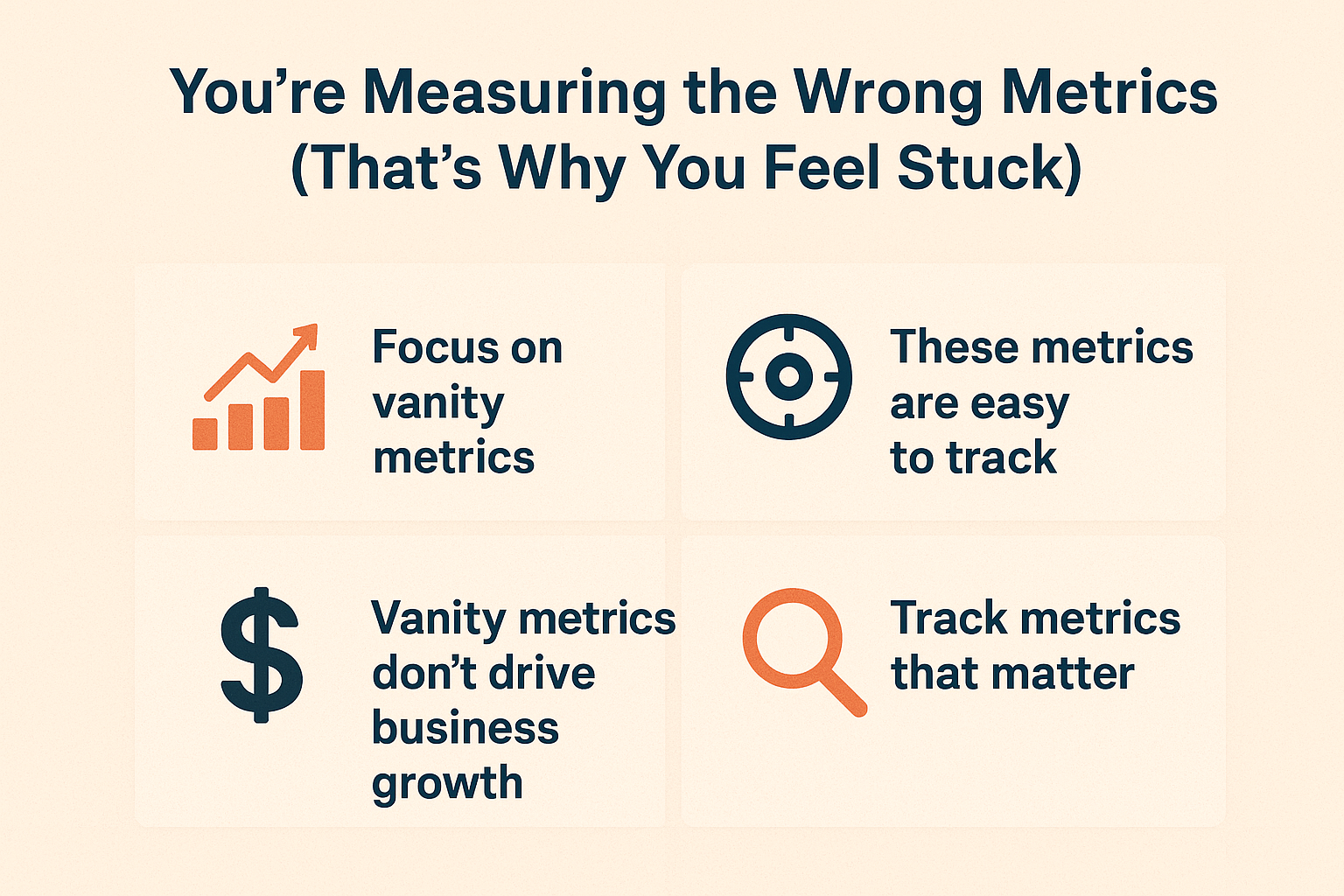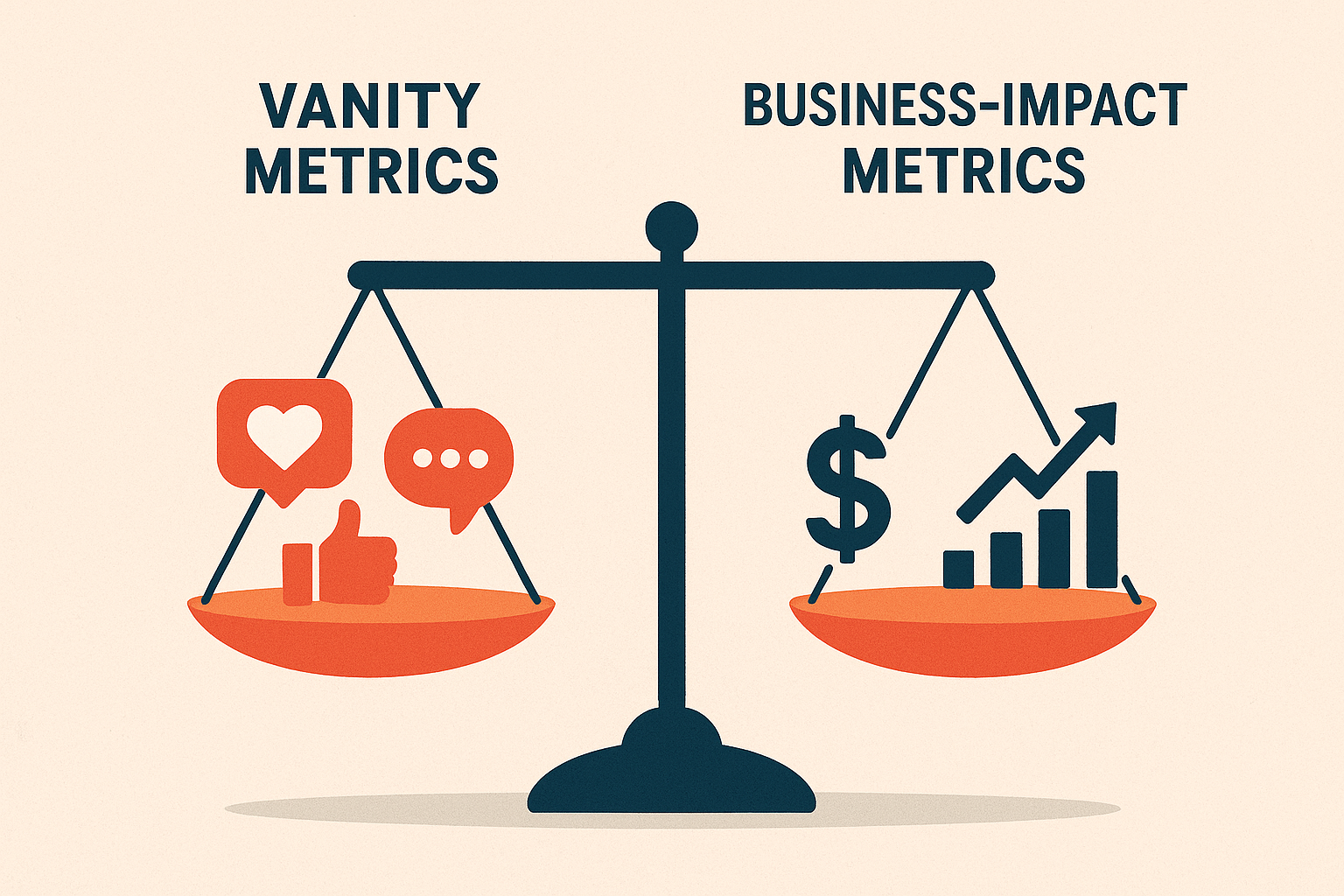Table of Contents
- Why Vanity Metrics Are Holding You Back
- The Metrics That Actually Matter
- The Cost of Focusing on the Wrong Numbers
- How to Shift Your Measurement Mindset
- The Role of Context in Measurement
- Building a Culture of Measurement That Drives Growth
- The Bottom Line
Why Vanity Metrics Are Holding You Back
Vanity metrics are the numbers that make us feel good but don’t necessarily tell the full story. Think:
- Followers on social media
- Page views
- Likes and comments
- Email open rates
These metrics are like empty calories—satisfying in the short term, but not nourishing for your business. They give the illusion of progress, yet don’t prove whether your efforts are profitable or sustainable.
For example, your campaign might generate thousands of likes, but if no leads convert into paying customers, your business impact is zero. Vanity metrics can also trick leadership into thinking marketing is working when, in reality, the pipeline isn’t moving.
The Metrics That Actually Matter
To grow, you need to measure business-impact metrics—numbers that show if your strategies are moving the needle on revenue, efficiency, and long-term customer loyalty.
Customer Acquisition Cost (CAC): How much does it really cost to gain one customer? If your CAC keeps rising while sales stay flat, something is broken in your funnel.
Customer Lifetime Value (CLV): Instead of chasing short-term wins, focus on the long-term value each customer brings. A high CLV means your customers are loyal and your retention strategies are working.
Conversion Rate: This shows how well your messaging, offers, and customer journey move people from interest to action. A small increase here often creates exponential growth in revenue.
Sales Pipeline Velocity: Measuring how fast leads turn into closed deals helps you spot bottlenecks in the process. Faster movement often signals better alignment between marketing and sales.
Retention & Churn Rates: It’s almost always cheaper to keep customers than to acquire new ones. A low churn rate is a powerful indicator of long-term health.
These aren’t just numbers—they’re signals about whether your strategy is delivering real outcomes.

The Cost of Focusing on the Wrong Numbers
Obsessing over vanity metrics has hidden costs. First, it wastes resources. Time spent optimizing for likes and impressions could be better invested in nurturing leads or improving customer experience. Second, it creates a false sense of security. Teams may report “growth” that looks impressive in dashboards but doesn’t translate into revenue.
Perhaps the most damaging cost is misaligned decision-making. When leadership relies on surface-level metrics, it becomes harder to justify investments in strategies that actually matter, like content quality, customer experience, or sales enablement. The result? Slow progress and a feeling of being “stuck” despite heavy activity.
How to Shift Your Measurement Mindset
Breaking free from the vanity trap requires discipline and clarity.
- Start with goals, not numbers. Every campaign should begin with a business objective: more customers, higher revenue, stronger retention. Once the goal is clear, identify the few metrics that directly connect to it.
- Audit your dashboards. Look critically at your reports. Which numbers genuinely help decision-making? Which are just “feel-good stats”? Trim the noise.
- Prioritize quality over quantity. It’s better to have 100 leads who convert than 10,000 website visitors who bounce. Focus on the strength of your funnel, not just the volume of traffic.
- Close the loop with sales. Marketing metrics only matter if they align with sales outcomes. Partnering with sales ensures you’re measuring the right things: revenue and customer growth.
The Role of Context in Measurement
Metrics don’t exist in isolation—they need context. For example, a conversion rate of 3% might look small, but if your average deal size is $50,000, that’s excellent performance. On the other hand, a million impressions may look impressive, but if they’re not reaching your target audience, they’re worthless.
Always ask: What does this number mean for my business goals? Without context, even the right metrics can mislead.
Building a Culture of Measurement That Drives Growth
The final piece of the puzzle is cultural. Organizations need to align around what success looks like. This means moving away from celebrating “likes” and “followers” toward recognizing wins like higher retention, shorter sales cycles, and increased customer value.
Leaders should model this mindset by asking tougher questions: not “How many people saw our campaign?” but “How much revenue did this campaign generate?” When the entire team embraces impact-driven measurement, energy shifts toward strategies that actually drive business forward.
The Bottom Line
If you’re stuck, it’s not always because your marketing isn’t working—it may be because you’re measuring the wrong things. Vanity metrics make you feel busy, but impact metrics drive real business growth.
By shifting your focus, you’ll stop chasing numbers that don’t matter and start making progress where it counts: revenue, retention, and long-term success.




